
Transcription
24.00ResidentialWiringto the 2011 NEC Eby Jeff MarkellPLRevised byRob Adair&SAMDan AtchesonMake Studying for the Exam FunOrder the Interactive Study Center download, withall the end-of-chapter test questions in interactiveself-test software. Only 19.99Go to www.craftsman-book.com or scan theQR code with your Smartphone Craftsman Book Company6058 Corte del Cedro / P.O. Box 6500 / Carlsbad, CA 92018
National Electrical Code tables are reprinted with permission from NFPA 70 -2011, Copyright 2010,National Fire Protection Association, Quincy, MA. This reprinted material is not the complete and officialposition of the NFPA on the referenced subject, which is represented only by the standard in its entirety.National Electrical Code and NEC are registered trademarks of the National Fire Protection Association, Inc.,Quincy, MA 02169.Production Manager, Christine Bruneau; design, layout and photographs, Joan Hamilton; image conversion,Lori Boon; cover photos, Ed Kessler Studios.PLESpecial thanks to Greg Haukap, LLC, Venice, FloridaLooking for other construction reference manuals?SAMCraftsman has the books to fill your needs. Call toll-free 1-800-829-8123or write to Craftsman Book Company, P.O. Box 6500, Carlsbad, CA 92018 fora FREE CATALOG of over 100 books, including how-to manuals,annual cost books, and estimating software.First edition 1984 by Reston Publishing Company, Inc.ISBN 0-8359-6661-5Second edition 1987 by Craftsman Book CompanyISBN 0-934041-19-9Third edition 1993 by Craftsman Book CompanyFourth edition 1996 by Craftsman Book CompanyFifth edition 1999 by Craftsman Book CompanySixth edition 2002 by Craftsman Book CompanySeventh edition 2004 by Craftsman Book CompanyEighth edition 2008 by Craftsman Book CompanyNinth edition 2012 by Craftsman Book Company
Introduction . . . . . . . . . . . . . . . . . . . .Electrical Energy. . . . . . . . . . . .778111214151718202326SAMHistorical Introduction. . . . . . . . . . .The Composition of Matter . . . . . . .Formation of Molecules . . . . . . . . . .Static Electricity. . . . . . . . . . . . . . . .Current Electricity. . . . . . . . . . . . . .Ohm’s Law . . . . . . . . . . . . . . . . . . . .Watt’s Law . . . . . . . . . . . . . . . . . . . .Electrical Measurements. . . . . . . . .Basic Electrical Circuits. . . . . . . . . .Effects of Electrical Energy. . . . . . .Study Questions . . . . . . . . . . . . . . . .of2 DistributionAlternating Current. . . . . . . .DC Sources . . . . . . . . . . . . . . . . . . . .Magnetic-Mechanical Generation. .Induction and AC Generation . . . . .Power in an AC Circuit. . . . . . . . . .Study Questions . . . . . . . . . . . . . . . .34Conductors. . . . . . . . . . . . . . . . . . 79Wire Materials . . . . . . . . . . . . . . . . .Wire Size. . . . . . . . . . . . . . . . . . . . . .Insulations . . . . . . . . . . . . . . . . . . . .Color Code. . . . . . . . . . . . . . . . . . . . .Ampacities. . . . . . . . . . . . . . . . . . . . .Study Questions . . . . . . . . . . . . . . . .PL15ECONTENTS292930354548Tools and Safety. . . . . . . . . . . . . 51Conventional Hand Tools. . . . . . . . .Electrician’s Hand Tools . . . . . . . . .Power Tools. . . . . . . . . . . . . . . . . . . .Test Instruments . . . . . . . . . . . . . . .Basic Wiring Techniques . . . . . . . . .Safety. . . . . . . . . . . . . . . . . . . . . . . . .Study Questions . . . . . . . . . . . . . . . .515457606367778384869091935Grouped Conductors . . . . . . . . 956Electrical Boxes. . . . . . . . . . . . . 111 Nonmetallic-Sheathed Cable. . . . . . Service Entrance Cable . . . . . . . . . . Underground Feeder Cable . . . . . . . Armored Cable . . . . . . . . . . . . . . . . . Flexible Metal Conduit. . . . . . . . . . . Liquidtight Flexible Metal Conduit. . Rigid Metal Conduit. . . . . . . . . . . . . Electrical Metallic Tubing . . . . . . . . Rigid Polyvinyl Chloride Conduit . . Surface Metal Raceways. . . . . . . . . . Surface Nonmetallic Raceways . . . . Multioutlet Assembly. . . . . . . . . . . .Study Questions . . . . . . . . . . . . . . . .Metal Boxes. . . . . . . . . . . . . . . . . . . .Single-Gang Boxes . . . . . . . . . . . . . .4-Iinch Square Boxes . . . . . . . . . . . .Multiple-Gang Boxes . . . . . . . . . . . .Cut-In Boxes. . . . . . . . . . . . . . . . . . .Octagon Boxes. . . . . . . . . . . . . . . . . .Weatherproof Boxes . . . . . . . . . . . . 17117118
1201221221241287 Wiring Switch Circuitsand Outlets. . . . . . . . . . . . . . . . . 131131137140145150153Plans. . . . . . . . . . . . . . . . . . . . . . . .A Residential Plan Set. . . . . . . . . . .Types of Plans and their Uses. . . . .Floor Plan Symbols. . . . . . . . . . . . .Design of the Electrical System. . . .Convenience Outlets . . . . . . . . . . . . .Lighting Requirements . . . . . . . . . .Branch Circuits. . . . . . . . . . . . . . . . .Cable Plans. . . . . . . . . . . . . . . . . . . .Wiring Diagrams. . . . . . . . . . . . . . . .TR/GFCI Circuits. . . . . . . . . . . . . . .Appliances. . . . . . . . . . . . . . . . . . . . .Service Load Computation. . . . . . . .Sizing the Service Entrance. . . . . . .Estimating Electrical Costs. . . . . . .Study Questions . . . . . . . . . . . . . . . 5511 Finish Wiring of New Work. .257257261262266269272273Receptacles. . . . . . . . . . . . . . . . . . . .Switches. . . . . . . . . . . . . . . . . . . . . .Appliances . . . . . . . . . . . . . . . . . . . .Light Fixtures . . . . . . . . . . . . . . . . .Light Bulbs. . . . . . . . . . . . . . . . . . . .Breaker Box. . . . . . . . . . . . . . . . . . .Study Questions. . . . . . . . . . . . . . . .12 Additions and Alterationsto Old Work . . . . . . . . . . . . . . . . 275Framing Types. . . . . . . . . . . . . . . . . Concealing Additions/Alterations . . Exposed Additions/Alterations . . . .Study Questions. . . . . . . . . . . . . . . .SAMPLSwitch Types. . . . . . . . . . . . . . . . . . .Wiring Switch Circuits. . . . . . . . . . .Wiring 3-Way Switch Circuits . . . . .Switch/Outlet Combinations. . . . . .Outlets. . . . . . . . . . . . . . . . . . . . . . . .Study Questions . . . . . . . . . . . . . . . . Flexible Metal Conduit . . . . . . . . . . Liquidtight Flexible Metal Conduit. . Electrical Metallic Tubing. . . . . . . .The Conduit Bender . . . . . . . . . . . .Surface Raceways . . . . . . . . . . . . . .Identifying Rough Wiring. . . . . . . .Study Questions. . . . . . . . . . . . . . . .EPlastic Boxes. . . . . . . . . . . . . . . . . . . NEC Box Regulations. . . . . . . . . . . .Number of Conductors Permitted. . Entrance of Conductors intoBoxes. . . . . . . . . . . . . . . . . . . . . . . .Study Questions . . . . . . . . . . . . . . . .The Service Entrance . . . . . . .Overhead Service Entrance. . . . . . .Underground Services . . . . . . . . . . .Meter Box. . . . . . . . . . . . . . . . . . . . .Breaker Box . . . . . . . . . . . . . . . . . . .Grounding. . . . . . . . . . . . . . . . . . . . .Grounding Electrode System. . . . . .Overcurrent Protective Devices. . . .Fuses. . . . . . . . . . . . . . . . . . . . . . . . .Circuit Breakers. . . . . . . . . . . . . . . .Combination Arc-FaultCircuit-Interrupter Breakers. . . . .Study Questions . . . . . . . . . . . . . . . .10231234Rough Wiring . . . . . . . . . . . . . . . 237Nonmetallic Cable. . . . . . . . . . . . . . 237 BX Cable. . . . . . . . . . . . . . . . . . . . . . 24227528028829213 Troubleshooting andRepairs . . . . . . . . . . . . . . . . . . . . 295Safety First. . . . . . . . . . . . . . . . . . . .Shorts. . . . . . . . . . . . . . . . . . . . . . . .Overloads. . . . . . . . . . . . . . . . . . . . .Receptacles. . . . . . . . . . . . . . . . . . . .Switches. . . . . . . . . . . . . . . . . . . . . .Light Fixtures . . . . . . . . . . . . . . . . .Checking New Wiring . . . . . . . . . . .Study Questions. . . . . . . . . . . . . . . .29529629930530630931531814 Supplementary Systems. . . . .321Signaling and Warning Systems. . . 321Communications . . . . . . . . . . . . . . . 328Entertainment andComputer Systems. . . . . . . . . . . . . 330Home Elevators andStairway Chairlifts. . . . . . . . . . . . . 332Residential Standby andOptional Power Systems . . . . . . . . 333Home Electrical VehicleCharging Stations . . . . . . . . . . . . . 335Study Questions. . . . . . . . . . . . . . . . 336Answers to Chapter Questions. . . 339Index. . . . . . . . . . . . . . . . . . . . . . . . . . . . 341
INTRODUCTIONTPLEhis book was written for anyone who intends to make a living wiring residential buildings. If you can understand and follow the instructions in thismanual, you should have no trouble installing safe, modern, efficient electricalsystems in homes and apartments.SAMAs an electrician, you need to know how to use a wide variety of tools andmaterials. This manual describes the tools that should be in every electrician’s toolbox, and suggests how they can be used to best advantage. I’ll also explain whatyou should know about electrical materials: wire, cable, conduit, fixtures, boxes,switches, breakers and panels. There’s a correct tool and a right material for everypurpose. Sometimes selecting the right tools and materials isn’t easy. After reading this book, you should have little trouble choosing both the tools and materialsappropriate for the work you do.This manual isn’t a book of electrical theory. But every professional electricianneeds some background on how electricity is generated and distributed. And, ofcourse, you should know how Ohm’s Law and Watt’s Law are used to design electrical systems. The first two chapters cover these important subjects.If you’ve worked as an electrician for some time, you know that nearly everything an electrician does is governed by the National Electrical Code , also referredto as NFPA 70 , published by the National Fire Protection Association (NFPA ),and the International Code Council (ICC) Electrical Code. For our purposes, theonly right way is the code way. Until you’re comfortable with the NEC , doingeverything the code way can be a nuisance. Once you understand the code and thereasons for code requirements, you may have a different perspective. Experiencedelectricians agree that the NEC protects everyone (including electricians andelectrical contractors) and is a good guide to professional practice and should befollowed — even if the building inspector didn’t spot a problem or enforce it.And here’s yet another reason to strictly adhere to the code. If ever there’s aproblem with the wiring in a building, such as an electrical fire, as long as you’vedone the installation to code, you’re probably off the hook. But if they find youhaven’t, they’re going to hang you on it.
6 Residential WiringThis book will help you follow the code, but it isn’t a substitute for the NEC.Every professional electrician needs a copy of the current code used in thejurisdiction where they’re working. Many bookstores sell the NEC, or you canorder a copy from this publisher, using the order form bound into the back ofthis book, or from their website: www.craftsman-book.com.But just having the current NEC isn’t enough. Many cities and counties don’tadopt the model NEC exactly as published, nor should you assume every jurisdiction is using the newest code. Each jurisdiction has its own way of reviewing thecode updates and approving them, with or without local practices and amendments.When the changes from one generation of code to the next code are insignificant,some jurisdictions choose to keep the old code and wait for the next revision.EOnce you have the NEC that’s adopted in the jurisdiction where you’re working, ask at the local building department about amendments or changes that applyin that jurisdiction. Keep those changes with your copy of the NEC. Sometimesemploying a local licensed electrician to work on a residence that’s not in yourusual jurisdiction is an option. Always keep in mind that you’re responsible for thehazards you encounter or produce while working on an electrical system.SAMPLIn this book I’ll explain floor plans, cable plans and wiring diagrams in detail.This is important information for every electrician. The code has a lot to say abouttypes of outlets, spacing of outlets, what must be switch-controlled and what neednot be switch-controlled. The work you do will have to follow the plans and comply with the code. The information in this book should help you understand andfollow plans prepared for your jobs. However, the diagrams I’ve included and theassociated text are meant to assist you with general knowledge, troubleshootingand advice in solving residential electrical problems. They aren’t designed for youto rely on unquestionably. They may be incomplete or contain jurisdictional errorsand may not always apply exactly to your specific problem. They are strictly teaching examples, and not intended for your direct use or for nonresidential electricalsystems or systems outside the United States.Finally, I’ll explain how to diagram the circuits you’re likely to find in a homeor apartment. As a teacher of electrical wiring for many years, I’ve found that astudent who can diagram a circuit correctly has a reasonably good chance of wiring it correctly as well. And a student who can’t diagram a circuit probably can’tinstall it either!Now let’s get down to business — what you need to know to wire homes andapartments.Jeff Markell
1PLIEELECTRICALENERGYSAMn order for electricians to understand their work sufficiently andkeep current in the field, they need a good background in electricityand its capabilities. But they also need to know some basics about thenature of matter, since the creation and transfer of electrical energy isprimarily a function of the properties of matter at the molecular level.Electricity has always been, and typically still is, mysterious. It’s aninvisible form of energy, but as you’ve probably discovered, it can makeits presence extremely evident. This is a practical book on how electricalwiring in a small building should be done to meet accepted standards ofgood workmanship, and to comply with the provisions of the NationalElectrical Code (NEC). It doesn’t focus on theory, so the discussion oftheoretical matters will be minimized.Historical IntroductionIt might be surprising that, as far back as 600 BC, the Greeks amazedthemselves with elementary uses of static electricity. For example, theydiscovered that a piece of amber rubbed with cloth attracted bits ofstraw, hair, etc. Their word for amber was “elektron,” which is the rootof “electron,” “electricity,” “electronics,” and other words containing“electro.”“The ancients” also discovered that certain heavy black stones theyoccasionally found mysteriously attracted iron. Since these stones wereoften found in a part of Asia Minor called Magnesia, they were called
8 Residential Wiringmagnets. Naturally, all manner of hocus pocus was created to explainthese curious phenomena — none of them with much semblance to thefacts as we now know them.PLEOver many centuries, observations indicated that various othermaterials had characteristics similar to amber. These materials couldalso be rubbed to attract light objects. Scientists developed a theory thatthe rubbed materials would leak a “fluid-like substance” that caused theattraction. This fluid was called electricity. Theorists of the early 18thcentury, discontent with just one “fluid,” hypothesized that there weretwo fluids. One was called “vitreous” and the other was “resinous.” Thedifference was based on the nature of the substance being rubbed. By themiddle of the 18th century, Ben Franklin went back to the “one fluid”theory. He decided that the two fluids were simply different aspects ofthe same thing. When an object had too much of this electric fluid itwas “positive,” if it had too little it was “negative,” and if it was neither,it was “neutral.” While those in scientific fields were dissatisfied withthis theory, it was the only one available until the early 20th century. Atthat later time, investigating the structure of matter produced a moresatisfactory alternative.MThe Composition of MatterSAMatter is anything that has mass and occupies space. It exists in thefollowing three states:1. Solid — such as rock2. Liquid — such as water3. Gaseous — such as the air around usWith variations in temperature and pressure, matter can be changedfrom one state to another. Remove enough heat from a quantity of waterby reducing the temperature, and at 32 degrees F, it’ll change from aliquid to a solid — ice. Add enough heat to the same quantity of water byincreasing the temperature, and at 212 degrees F it’ll start to vaporize,changing from a liquid to a gas.Although a particular type of matter may change state from solidto liquid to gaseous, the component building blocks it’s made of remainthe same. So, “What’s matter made of?” To find out, we must divide,subdivide and subdivide again to reach the smallest particle thatmaintains the characteristics of that type of matter, such as water, steel,or foam plastic. The smallest particle that maintains the characteristicof the material is a “molecule.” Each kind of matter has a correspondingdifferent molecule. But the molecule definitely isn’t the smallest part.
Electrical EnergyMolecules are composed of even smaller parts called “atoms.” Water,for example, is composed of molecules made of two hydrogen atoms plusone oxygen atom — H2O. All matter, then, consists of the atoms of some118 elements combined in different compounds to form the moleculesthat distinguish different substances from each other. We will discusshow atoms accomplish combining into molecules after we look moreclosely at the atom itself.EThe atoms that compose molecules are quite complicated structures.Each one seems to be a miniature solar system, consisting of a nucleussurrounded by varying numbers of revolving electrons. The nucleuscontains various particles, such as protons, neutrons, positrons, neutrinos, mesons, and even a few odd bits called “quarks” and “charms.”We’re primarily concerned with the bulk of the nucleus consisting ofthe protons and neutrons. The number of protons in the nucleus differentiates the atoms of the 118 elements from each other. The numberof protons in the atom’s nucleus is its “atomic number,” for examplehydrogen is #1, helium is #2, and so on.MPLProtons are positively charged, neutrons have no electrical charge,and the orbiting electrons are negatively charged. Since, under normalconditions, atoms are electrically neutral, an atom of any elementwill contain equal numbers of electrons and protons. The number ofneutrons, along with the various other nuclear components (neutrinos, mesons, etc.), has nothing to do with the electron-proton balance.Hydrogen has no neutrons, while the 92 protons of uranium areoutnumbered by 146 neutrons.SAWhile the magnitude of the opposite electrical charges in electronsand protons is equal to each other, the difference in mass betweenthe two is staggering. The mass of a proton is 1,840 times that of anelectron. There’s a similarity between what’s observed on a huge scalein the solar system to the minute scale in the atom. All but a tiny part ofthe solar system’s mass is contained in the sun. Similarly, all but a tinypart of an atom’s mass is contained in the nucleus.The solar system’s planets are held in their orbits around the sun bycomplex factors involving the mutual attraction of their gravitationalfields with the sun’s, and their masses and velocities. Electrons are heldin their orbit around the nucleus by the electrostatic attraction betweentheir negative charges and the proton’s positive charges in the nucleus,including a relationship between mass and velocity.At this point, the parallel between the atom and the solar systembreaks down. Each planet of the solar system differs greatly from theother in mass, composition, orbital velocity, and other characteristics.However, the electrons orbiting the nucleus of an atom do not differ.The electron must maintain a constant speed to sustain the centrifugal force that keeps it from falling into its nucleus or spinning awayfrom its nucleus. Because of its mass, it must also have a level of energy9
10 Residential Wiring–––18-electron orbit, complete–––8-electron orbit, complete––––––2-electron orbit, complete–––29 ––––––––––––1 electron in an 8-electronorbit, incompleteFigure 1-1Diagram of an atomPLE––Mresulting from a combination of its mass and velocity. Only a very limitednumber of specific energy levels are possible for electrons; there areseven altogether. As an electron can only occupy an orbital path suitableto its energy level, there are seven possible orbits.SAThe more complex atoms might have as many as 100 electrons, butsince only seven possible energy levels exist, the electrons must group atvarious appropriate orbit distances from the nucleus, forming “shells”in layers around it. See Figure 1-1. A consistently repeated pattern isfound in the formation of these shells. The innermost shell (#1) can holdno more than two electrons. Any number above two starts the secondshell, which holds up to eight. When it’s filled, the third shell is started.At this point, the picture becomes a little more complicated. Thethird shell (#3) holds up to 18 electrons; however, the outermost shellof any atom, regardless of which one, can’t hold more than eight. So,when shell #3 is on the outside, with eight electrons, the next electronmust orbit in shell #4. Only after shell #4 has one or two occupantscan the rest of the 18 possible spaces in #3 be filled. When shell #4 haseight electrons, shell #3 will already have its allotted 18. When #4 is theoutermost shell, holding eight electrons, then shell #5 starts. Shell #4can hold 32 electrons. When it has 32, and shell #5 is up to eight, shell#6 is started. Once shell #6 is completed and shell #7, the last possibleelectron shell is started in a similar way. With all elements, it’s the spareelectrons of the outer shell — whatever shell number that is — that takepart in any of the various chemical and electrical phenomena. These arecalled “valence electrons.”
Electrical EnergyFormation of MoleculesRegardless of its shell number, the outermost shell of any atomcan’t contain more than eight valence electrons. Any atom that has alleight is stable, and doesn’t normally combine with other atoms. Theatoms with valence electrons anywhere between one and seven, tryingto attain stability, are available to combine with other atoms to formmolecules. The process of molecule formation is called atomic bonding.This process occurs in any one of the following three ways:1. Ionic bonding2. Covalent bonding3. Metallic bondingEIonic BondingMPLAn atom alone will contain matching numbers of electrons andprotons, which, since they have opposite electrical charges, results in aneutral charge for the atom as a whole. However, this matter of valenceelectrons gets in the way. An atom with more than four but fewer thaneight valence electrons is unstable. It tries to obtain whatever numberof valence electrons is missing to fill its outer shell to eight. In contrast,an atom with fewer than four valence electrons is also unstable, butwilling to unload its excess.SAWhere an atom with one valence electron meets another one withseven, there’s a tendency for the one to join the seven, stabilizing bothatoms. However, in the process, something else happens. The atom thatlost an electron now has a net positive electrical charge of one. Theatom that picked up an electron has a net negative electrical charge ofone. An atom that’s no longer electrically neutral but has a net positiveor negative charge has become an “ion.” Ions with opposite electricalcharges are attracted to each other, tending to combinevia “ionic bonding” to form molecules.Covalent BondingFigure 1-2Covalent bond of two hydrogen atomsHydrogen with the atomic number “1” has only asingle electron in the #1 shell. It’s unstable becausethat shell is incomplete without two electrons. One wayit stabilizes is to join with another hydrogen atom toform a hydrogen molecule in which the two componentatoms share their two electrons. See Figure 1-2. This isan example of “covalent bonding.”11
12 Residential WiringMetallic BondingCopper is a good example of “metallic bonding” because it’s the mostcommonly-used material for electrical wires. The atom in this case has29 electrons. Shell #1 is complete with two, shell #2 is complete witheight, and shell #3 is filled with the next 18. That totals 28. The 29this a lone valence electron in shell #4, which is loosely held and has atendency to wander off, becoming a “free electron.” The copper atomhas become a positive ion, and so have a lot of other atoms that havealso lost their single valence electrons. Although like charges repel, thecopper ions don’t simply fly apart as one might expect. They’re immersedin a sort of soup of free electrons. The mutual attraction between thepositive copper ions and the negatively charged electron mass aroundthem holds the whole substance together by “metallic bonding.”EThat same soup of free electrons, unattached to specific atoms, flowsas an electrical current through a metal when it’s connected to a sourceof electrical pressure. We measure that pressure in volts, and measurethe current it creates in amperes.PLThe more free electrons available in a given material, the morereadily they’ll move in response to a given electrical pressure; the morefree electrons in a material, the less “resistance” it’ll have to the flow ofthose electrons as electrical current.SAMMaterials containing large numbers of free electrons, and thereforeoffering little resistance to the flow of electron current, are called“conductors.” Those with very few free electrons will inevitably have ahigh resistance to the flow of electron current, since there are only a fewavailable electrons to participate in the process. These materials, due totheir high resistance, are good insulators.Metals in general, because of metallic bonding, have many freeelectrons and are good conductors. Glass, rubber, wood, cloth, andplastics, having few free electrons, are good insulators. A few materials exist that don’t fall into either conductors or insulators. They havesome of the characteristics of both, so they’re called semiconductors.Silicon and germanium are two. These types of materials are used invarious electronic devices, but not directly in building wiring; so theywon’t concern us.Static ElectricityUnder normal conditions, the atoms of a substance are neutrallycharged, since the negative charges of the orbiting electrons are exactlybalanced by the positive charge of the protons in the nucleus. When two
Electrical EnergySource of positive chargeGases containing dust,soot, and solidsGases GroundFigure 1-3Smoke precipitatorPLEDust, soot, and solidsMelectrically unbalanced atoms bond ionically to form a molecule, thatmolecule also becomes neutral, since the net positive charge of one atomhas been offset by the net negative charge of the other.SAHowever, when an outside influence forces many atoms of a materialeither to gain or lose an electron, that material either becomes negatively or positively charged. This charge collects on the object’s surface andtends to stay there until it’s conducted away. The pieces of amber thatwere rubbed with cloth by the Greeks in 600 BC were charged in thisway. When you walk across a thick carpet and touch a door knob, thesmall spark you receive is the same kind of charge. This type of surfacecharge is called a static charge.One important use of static electricity is in cleaning solid pollutants,such as soot and dust, from the exhausts of industrial plants. We rarelysee black smoke belching from factory smoke stacks the way we usedto. Now, those gases are vented into a precipitation chamber, where apositively-charged plate attracts the solids suspended in the gas. Themoment they touch it, they become positively charged and are stronglyrepelled. They then drop to the bottom of the chamber, where they arecollected and dis
Call toll-free 1-800-829-8123 or write to Craftsman Book Company, P.O. Box 6500, Carlsbad, CA 92018 for a FREE CATALOG of o
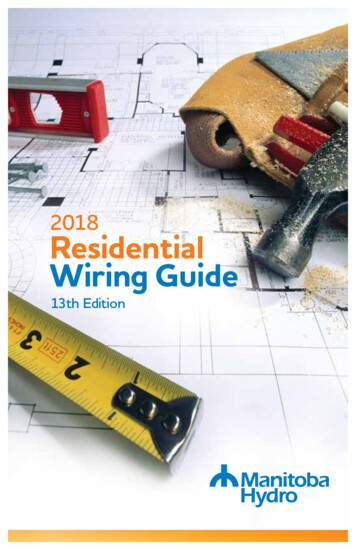
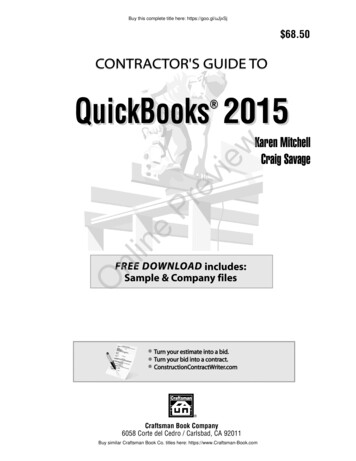

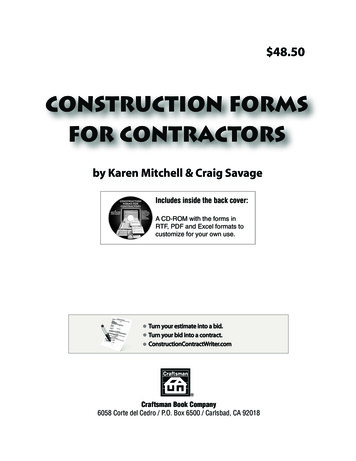

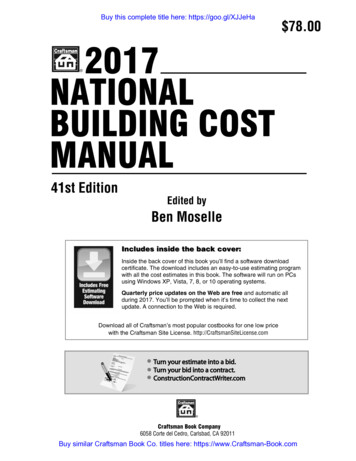
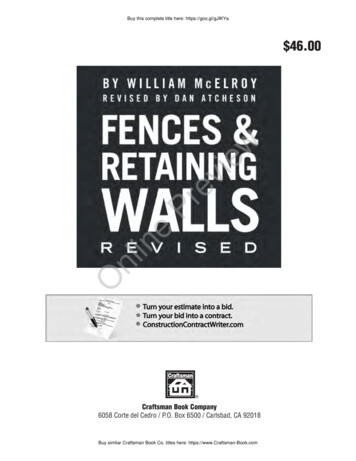
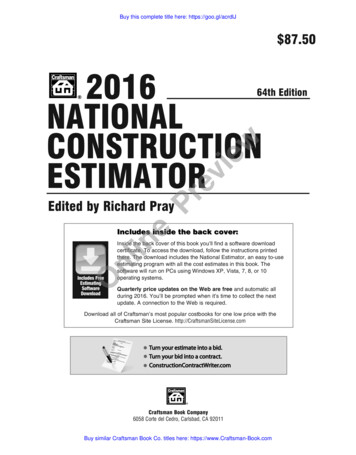
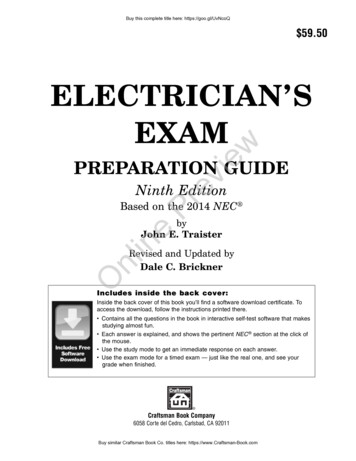


![Shareholders’ Agreement of [Company name] company. 1 .](/img/1/startup-founders-sha-sample.jpg)